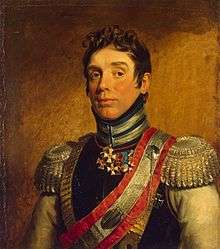Karl Ludwig von Budberg
Baron Karl Vasilievich Ludwig von Budberg (9 July 1775–8 September 1829) was an Imperial Russian cavalry general and nobleman who participated in the Napoleonic Wars.
Karl Vasilievich Ludwig von Budberg | |
|---|---|
 | |
| Born | 9 July 1775 Governorate of Livonia |
| Died | 8 September 1829 Turkey |
| Allegiance | |
| Service/ | Army |
| Years of service | 1786–1829 |
| Rank | Lieutenant General |
| Commands held | His Majesty's Life-Guards Cuirassier Regiment 2nd Brigade of the 1st Cuirassier Division 2nd Hussar Division |
| Battles/wars | War of the Second Coalition War of the Fourth Coalition |
| Awards | Order of St. George Order of the Red Eagle Order of St. Vladimir Order of Saint Anna Order of Saint Alexander Nevsky Order of Leopold (Austria) Military Order of Max Joseph Kulm Cross Gold Sword for Bravery |
Biography
Born to a noble Baltic German family in the Governorate of Livonia, von Budberg first joined the military at the age of eleven. He participated in the Italian and Swiss expedition and the Anglo-Russian invasion of Holland in 1799 and was promoted to Lieutenant Colonel by 1801.
During the War of the Fourth Coalition, von Budberg fought in the battles of Guttstadt-Deppen, Heilsberg, Friedland, and Eylau, at which he was wounded in the arm.
In 1811 he was made chief of His Majesty's Life-Guards Cuirassier Regiment, and maintained this command through the French invasion of Russia and the subsequent War of the Sixth Coalition, where he distinguished himself in numerous battles, including Borodino, Kulm, and Leipzig. He was promoted to Major General in 1813.
In 1816 von Budberg was made commander of the 2nd Brigade of the 1st Cuirassier Division, and then commander of the 2nd Hussar Division in 1824. In 1826 he was promoted to Lieutenant General and then fought in the Russo-Turkish War of 1828, during which he died of a sudden illness.[2]
References
- The State Hermitage. Western European painting. Catalog. 2nd Volume
- Alexander Mikaberidze (19 January 2005). Russian Officer Corps of the Revolutionary and Napoleonic Wars. Savas Beatie. pp. 49–50. ISBN 978-1-61121-002-6.